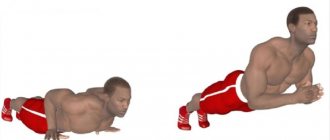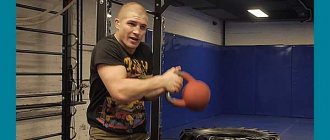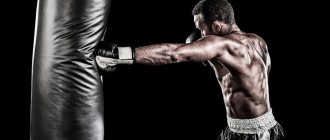The lion's share of men, sooner or later, is faced with a situation where they need to enter into conflicts on the street, in institutions and any other places. It is at such moments that the combat skills that a person possesses come in very handy. But, unfortunately, not everyone has them.
In order not to become a victim of circumstances, it is worth figuring out whether it is possible on your own, that is, at home, or with the help of trainers, to hone your fighting skills and how to make your arms and legs an effective weapon that will help protect not only yourself, but also your loved ones in a critical situation .
How to make a fist, which strike to choose and other answers to self-defense questions
Perhaps in the life of any man there have been situations when he had to use his fists for defense. And we are talking here, of course, not about those who like to fight, who are not able to control themselves, but about those who really had to defend themselves in order to protect themselves from the physical aggression of other people.
And in order for this defense to be successful, it is at least important to know, or rather be able to deliver the correct blow with your hand (left or right, it doesn’t matter). After all, an incorrectly delivered blow may not only not end the fight with a positive result for you, who is defending yourself from a human aggressor, but also lead to fatal consequences if you:
- missed (in this case, while you are disoriented for a split second and are in an unstable position, most likely you will immediately receive a retaliatory blow to unprotected parts of the body);
- got hit, but injured their own hand (knocked out/broke a finger that was placed incorrectly into a fist, twisted their wrist, or injured their hand in some other way);
- they just didn't hit hard enough;
- or, finally, they shifted their elbow so much or stood in such an unstable stance that after a blow you can be dropped simply by blowing...
In general, as you can see, there are many nuances and plenty of options for errors. In our short post we will only describe in general terms what to pay attention to if you want to master the basics of punching. However, it is important to remember that no brochure, even the most thoroughly analyzed by stages, will be able to allow you to replace practice with theory.
Moreover, practicing from books or gaining knowledge from videos, of which there are many now available on video hosting sites, also does not make much sense. It is much better to take practical lessons from an intelligent, knowledgeable trainer. He will show you everything in practice, and with practice he will reinforce all the movements together with you (at least the basics). And then - polish the acquired motor skills and the delivered blow and, if you want, study the art of self-defense further.
Impact block
At this stage, classes are carried out with equipment, weights and fights (first with a shadow, then with a partner).
The list of required activities includes:
- Working with a pear weighing 20-30 kg. Such a projectile does not fly off after the initial impacts. And when working with it, the likelihood of joint damage is low. Hit the bag from the correct stance and using the basics of the striking system.
- Training with dumbbells weighing 2-5 kg. If the shape allows, you can take options for 8-9 kg. Take them in your hands and hit them in the air. This is how strength, endurance and dynamics are developed.
Load on each arm: 10 circles of 12-15 repetitions.
Don't pile up your dominant hand. Instead, focus on developing your weaker hand.
Gradually increase the weight of the apparatus as you become accustomed to the modest weights.
- Shadow fight. Develops attacking dynamics and power. Throw out blows in series, for example 3-4 pieces. And each subsequent one must be stronger than the previous one.
Load – 5 rounds of 3-5 minutes, separated by two-minute pauses.
Practice a variety of strikes and their combinations, for example: jabs with uppercuts, hooks, etc.
You can compete with the shadow while in the pool. The blows follow from the water, overcoming its resistance.
In this fight you can work with dumbbells weighing up to 5 kg. And try to achieve maximum speed.
We've all seen fights in movies, but in real life such options most likely won't work...
Let's turn to the guru of international life hacking - the site lifehacker.com, which provided a list of general tips on how to learn the theoretical basics of a fist fight, so that you can at least imagine in your head what it might look like in reality.
Journalists tried to figure out how to fight correctly by interviewing several experts who compiled a list of tips that could help in the study. Including:
- the correct way to make a fist;
- correct orientation in space of the wrist;
- where to hit;
- and what to do after the impact.
The goal of a well-placed punch is to deliver an effective punch without harming yourself.
First block
All training can be divided into three complexes: developmental, position training and striking. In the first, the necessary parts of the body are strengthened. In the second, correct execution is honed.
The first block includes the following exercises:
- Underwire stand and push-ups on a wooden surface. This involves rolling from one fist to the other. Load – 2-5 minutes or 2 circles of 10-15 repetitions. You can proceed to point two only after completely mastering this exercise.
- Stand on surfaces made of metal, concrete and stone. The load is identical. Duration – 1-2 months daily. If it becomes very difficult, you can reduce the number of classes to 3-4 per week. Only after this can you start step 3
- Lying emphasis. Here the hands are alternately placed behind the back. In this case, you need to stand on one fist. The mining first takes place on a wooden surface, then moves on to iron and concrete.
- Near the wall. Variation 1. Near it you need to stand on your fists, position yourself upside down and raise your legs, and then do push-ups on your fists. Rolling from one fist to another is allowed.
- Near the wall. Variation 2. Here a stand on one fist is performed. The duration is as long as you can.
- Walking on wood with fists for 1-2 weeks, after which the actions take place on concrete and metal.
Gradually after these points the bones will get stronger and become like stone.
How should you clench your fist when hitting?
Before punching, you must know where your thumb should be placed. This is an important, even extremely important point - the thumb should be on the outside of the fist, between the first and second joints on the index and middle fingers. Like this:
photo: ru.wikihow.com / www.facebook.com
“If the thumb is encircled by the other fingers, that is, inside the fist, then when struck, there is a high probability that it will be broken/knocked out,” says Ayman Farooq, a second-degree black belt and American martial arts instructor.
Keith Horan, holder of a fourth degree black belt in American kempo karate, speaks in the same spirit, who especially notes that the thumb should be kept under bent fingers, which will not only prevent it from being injured, but will also not create obstacles during strikes.
How to avoid knocking out your knuckles?
photo: unsplash.com / Luis Quintero
As for your knuckles...
In the standard type of punch, you need to clench your fist very tightly and hit with a flat surface, but not with your knuckles. Otherwise, you knock out one of them, a fracture may occur, which will not only take a very long time to heal, the joint will hurt for several months, but also the functioning of the finger may be impaired (perhaps even forever).
The blow should ideally fall on a line of all four knuckles, and not on a separate finger.
Of course, there are completely different techniques for making a fist with your fingers. For example, as Karate and Taekwondo martial artist Chris Wagspack reminds us, in some schools of martial arts or types of hand-to-hand combat, the index and middle finger knuckles may be positioned a little further in front of the main plane of the fist when striking.*
*But this is just an illustration. It is contraindicated for a beginner, or even a person with an average level, to use such a technique, since it is suitable only for certain types of strikes, but is also extremely traumatic or can unduly influence the enemy, even to the point of death.
Are full knuckles a plus or a minus?
photo: quora.com
And a few more words about the knuckles. So, to minimize the likelihood of injury, experienced fighters stuff their knuckles. After all, only a full fist allows you to strike with minimal losses to yourself.
Calluses on hard knuckles act as a kind of very effective buffer, protection for the delicate joints of the hands. Plus, they look intimidating and may be able to scare away not very aggressive citizens who will think about whether they should contact you or not.
The hand should be a direct continuation of the forearm
photo: Getty Images
On the one hand, this is logical - the entire arm straightened at the moment of impact, from the hand to the forearm and back, should be monolithic and rigid. But this is only at the moment of direct contact of the fist with the opponent.
In other words, the hand facing the opponent should not be restrained. As momentum builds up from the shoulder and hip, as well as the forearm muscles, the main task of the hand, in combination with your vision, is to accurately hit the target.
As trainers advise, in general the following scheme should apply:
- the beginning of the impact - the muscles of the arm and body work to gain speed;
- punch (direct punch*) - a fully straightened arm in which the elbow does not go to the side;
- moving the hand back to move into a defensive stance and choosing the next target to strike - the fingers are relaxed, the arm muscles are free...
Recommendations for girls
Today, female representatives are increasingly interested in fitness and fighting disciplines. Few become professionals. But the acquisition of the necessary skills still occurs.
Beginners usually have this question: how can you learn to punch a girl hard?
Here, too, classes are divided into three blocks (indicated earlier). Without strengthening the hands and practicing the positions, striking practice does not occur.
Girls should also do push-ups with their fists. Indulgence concerns surfaces - only wood. Although many ignore them and do push-ups on concrete and stone just like men.
The correct position of the legs and arms, the work of the hips and body is a mandatory criterion for all practitioners, regardless of gender.
The differences relate to training with apparatus. Lighter products are used, for example, dumbbells weighing 2-3 kg and bags up to 25 kg.
Many girls enjoy shadowboxing and working with a small ball. It is tied to a thread that is attached to the ceiling. Its length should be such that the ball is on the line of the nose.
This projectile is attacked, dodging it when it comes back.
*4. Direct strike or which strike should a beginner choose as his main one?
photo: unsplash.com / Alexander Jawfox
Perhaps the most understandable type of blow, familiar to every person since childhood, is a direct blow. It is not for nothing that this natural throw of the hand is present in, perhaps, any fighting system: boxing, karate, Mau Thai and others.
Therefore, the answer to the question of choosing a blow with which to start learning is obvious - it’s a straight blow !
Punching with a hand
YouTube
Explanations from boxing legend Konstantin Tszyu
The main thing in this movement is to understand that a correct punch is not just a “throw” of the arm towards the enemy, that is, the blow is not delivered due to the strength of the arms. No. The correct blow with the hand is applied using the weight of the body, that is, while simultaneously folding force into a single movement:
- hips;
- shoulder;
- hands
A correct blow (we are talking about a direct blow) should be accompanied by a push from the feet, a turn of the pelvis, a turn of the body, and a movement of the shoulder of the striking arm towards the target.
Should the elbow go to the side?
It is rightly believed that it is extremely important to align the two joints of the arm (elbow and hand joint) with the forearm for maximum rigidity. However, even among professionals there is debate about where the elbow should point and whether it should protrude slightly (slightly)…
So, in karate, when striking straight, the elbow should be pointing down. In the boxing style of striking, the elbow turns slightly to the side.
In this case, as we indicated above, we will allow a small bend angle of the elbow, which will not allow knocking out or damaging the elbow joint or putting the hand in a vulnerable position in the final phase of the blow.
“The most common mistake I see beginners make is bending their wrists forward or back and hitting with the top of the hand or the area between the first and second knuckles of the heel of the hand,” notes Farooq.
Padding
Well, as promised, I’ll tell you about the stuffing. In fact, this process is not so much difficult as it is long. By stuffing your striking limbs, you stop feeling pain due to the fact that a callus forms on the bone. It is he who protects our soft parts from pain. That is, your task is to deliver weak blows to hard surfaces over a long period of time.
In it you will find a universal system. It will allow you to learn boxing techniques at home and apply them even in street fighting!
The last thing I want to say is: The most important thing is not to give up at the beginning of your journey. The goal may seem unattainable, but it is worth it! Everyone in life has their own dreams and desires that they need to fight for. It is victory over yourself that will bring you real joy and self-confidence.
I'll end on this note
Subscribe to my blog and many new discoveries await you. Also write your questions in the comments and be sure to repost and like. Until next time.
Source
Do I need to learn different strike forms?
We’ll answer right away: yes! Moreover, any type of martial arts is a complex that is learned by the body in practice and brought to the point of automatism, a reflex! Learning one punch and defeating opponents in and out of the ring is a myth. This is impossible to imagine.
Even if you choose several strikes as your base (and this will need to be done, we have given one of the strikes only for illustration, example): straight, hook and some kind of uppercut - hone them in training and learn how to hit the enemy’s vulnerable points, that’s all there will still be no guarantee that you will emerge victorious from a fight even one on one. Everything can depend on chance and chance.
Perhaps you have not paid enough attention to training to repel an attack; perhaps your stance is incorrect (forearms and elbows do not protect your torso and it is easy to penetrate). But you never know - your friends have arrived to help your opponent... There are many nuances. Just one example of competent motor skills:
if your chin is down and the punch goes straight, the shoulder will automatically rise and protect your chin even more.
Where should you aim?
Since you want the fight to end as quickly as possible, you will try to incapacitate your opponent as quickly and efficiently as possible so that you can run away (yes, one of the best strategies in a dangerous situation) and call the police.
As tempting as it may be to punch your opponent in the face, Horan says it's the wrong move:
“You'll either miss or usually hit it wrong and break your fingers. For beginners, it is best to strike a blow to the body, to the chest or side, for example, to the ribs,” he notes.
By the way, remember that it is impossible or not recommended to hit some parts of the body - for example, in the throat, hard in the nose, in the heart area... If the blow is serious, a person may die from it. But who, in the heat of battle, will think about such “little things”! But in vain, because you shouldn’t forget about article number 114 of the Criminal Code of the Russian Federation. “Inflicting serious or moderate harm to health when exceeding the limits of necessary defense...”
1. Intentional infliction of grievous bodily harm, committed when exceeding the limits of necessary defense, -
shall be punishable by correctional labor for a term of up to one year, or restriction of freedom for a term of up to one year, or forced labor for a term of up to one year, or imprisonment for the same term.
Or even more serious - Article 108 of the same Criminal Code, if a murder occurred when the limits of necessary defense were exceeded.
The benefits of gym classes and psychology
Many people are afraid to strike. You can hit the punching bag perfectly, but in reality fail to hit the offender in the face at the right moment. Others are afraid of a fight, and still others even perceive any conflict as a mortal threat to their lives. To correct the situation, and not just hit a punching bag at home, you should still think about going to a boxing class or any other type of martial arts, and all because:
- It is a trip to the gym, to a coach, to new guys and unusual sensations that can change your attitude towards the current situation;
- Sparring – learning to hit people you don’t know or see them only a few times, even in the training process, will help relieve psychological stress and liberate the athlete;
- Blows taken. Over time, the brain adapts to everything, and it is thanks to this ability that almost everyone can stop being afraid of getting hit in return;
- In the gym, under constant stress, the body will be able to develop the habit of responding adequately to a rapidly changing environment;
- Self-confidence will increase in direct proportion to gaining new knowledge and honing your skills.
Be that as it may, to practice a good blow, a person must put in a lot of effort and spend time on it. Working with professionals, this task will become feasible and, quite possibly, will radically change the life of any person.
Strong is not the one who wins a fight, but the one who was able to prevent it
From this we conclude: the basics of self-defense in hand-to-hand combat are necessary, but they should be used in exceptional circumstances. It's better to prevent a fight by negotiating or just walking away. If you can't avoid it, run. Even if you are 1,000% right, if something happens to your counterpart in a fight, you will be responsible if the court considers that the limits of self-defense were exceeded. Well, or you can become a victim. It will be a shame to receive a disability when the problems could have been avoided.
PS If you live in an area with a bad crime situation, make it a rule to carry a spray can with you for self-defense. It will be difficult for even a good karateka or boxer to resist him! But you also need to know how to use a spray can...
Cover: unsplash.com / Dan Burton











